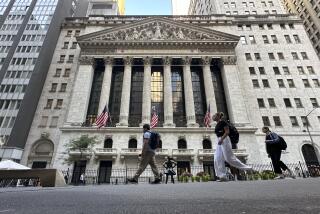Stocks Drop Again in Quiet Trading; Dow Declines 3.10
NEW YORK — Stock prices pulled back in subdued trading Friday as the market suffered its fourth straight losing session.
The Dow Jones average of 30 industrials drifted at slightly higher levels during much of the day, but late selling dragged the blue chips down and left the indicator 3.10 points lower at 1,774.68.
“I think the market is going to be quite erratic after the damage that was sustained in Wednesday’s selloff,” said Eugene Peroni, director of technical research for Bateman Eichler, Hill Richards. “It will take several weeks for the market to get over the trauma.”
On Wednesday, the Dow Jones industrial average plunged a record 41.91 points. Its weekly loss of 60.89 points was exceeded only by the 82.50-point dive that it took in the five trading sessions ended April 4.
At the final bell, losers held a narrow lead over gainers in the overall tally of issues listed on the New York Stock Exchange.
Volume on the Big Board contracted to 126.27 million shares from 146.48 million Thursday.
Phillips Volume Leader
A sharp rebound in oil prices on commodities exchanges benefited oil stocks but hurt transportation issues.
Phillips Petroleum was the volume leader and closed up at 9 7/8. Chevron gained 1 to 39, Exxon 1 3/8 to 58 and Mobil 3/4 to 29 3/4. All were among the 15 most heavily traded stocks.
The Dow Jones average of 20 transportation issues fell 5.39 to 786.56.
Uncertainty over the economy’s health and fears that interest rates will rebound left some investors reluctant to trade heavily.
A Labor Department report that the civilian unemployment rate fell 0.1 percentage point to 7.1% in April indicated that the economy got off to a sluggish start during the second quarter.
IBM led the decline in the blue chips, falling 2 3/4 to 154 1/8. AT&T; fell 1/8 to 24 7/8, General Electric 1/8 to 76 7/8 and 3M 2 to 102.
Other actively traded issues included several utility stocks, which encountered strong selling earlier this week amid concerns stemming from the nuclear disaster in the Soviet Union. Commonwealth Edison rose 1/2 to 31, Gulf States 3/4 to 10 3/4 and Long Island Lighting to 12 1/8.
Nationwide turnover in NYSE-listed issues, including trades in those stocks on regional exchanges and in the over-the-counter market, totaled 150.59 million shares.
Uncertainty over how well the credit markets will absorb a flood of new U.S. securities next week helped push interest rates higher in quiet bond trading.
The Treasury on Tuesday is scheduled to hold the first of three auctions that will sell a total of $27 billion in new notes and bonds.
The fall of bond prices over the past several trading sessions has reflected uncertainty by many traders over what the market’s reception will be for the new securities--and whether the market can count on heavy foreign buying. Weak demand for the securities would push interest rates higher.
Awaiting Outcome of Economic Summit
“It is of some concern to the marketplace whether we can underwrite these size securities without a ratcheting down of prices,” said William Sullivan, senior money-market analyst for Dean Witter Reynolds.
Investors also are awaiting the outcome of the economic summit that begins this weekend in Tokyo. Many believe that the summit could determine whether the major industrialized nations will allow the dollar to continue its fall.
Sullivan said a slight rise in oil prices Friday on the futures markets helped depress bond prices.
The Merrill Lynch daily Treasury index, which measures price movements on all outstanding Treasury issues with maturities of a year or longer, fell 0.55 to 118.33. The Shearson Lehman daily Treasury bond index, which makes a similar measurement, fell 2.85 to 1,234.07.
In corporate trading, industrials and utilities fell 1/2 point in light activity.
In trading among tax-exempt municipal bonds, general obligations were down in light trading and revenue bonds fell point in moderate trading.
Yields on three-month Treasury bills fell two basis points to 6.10%. Six month bills were down two basis points to 6.12%, and yields on one-year bills rose by one basis point to 6.17%.
Yields on 30-year Treasury bonds rose to 7.61% from 7.54% late Thursday.
More to Read
Inside the business of entertainment
The Wide Shot brings you news, analysis and insights on everything from streaming wars to production — and what it all means for the future.
You may occasionally receive promotional content from the Los Angeles Times.










